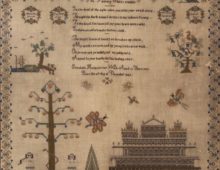Tagged with Punishment
Resource : The Rajah Quilt
Transportation was an extremely harsh punishment of the 1700s and 1800s, second only to execution. Between 1787 and 1852 as many as 25,000 women were transported from Britain to Australia to work in penal colonies, for crimes as varied as petty theft and poaching, to murder. Their sentences were often miscarriages of justice. Many didn’t survive the long journey. Most of them never returned. This remarkable quilt was made by women transported to Tasmania in 1841.
Resource : French Guillotine Blade
The guillotine is best known as a method of executing those condemned to death during the French Revolution. Although it delivered a grisly end – by slicing off its victim’s head, death by guillotine was quick and humane. During the ‘Reign of Terror’ in France, as many as 40,000 people were executed by ‘Madame Guillotine’.
Resource : Newgate prison door
Newgate Prison was located on Newgate Street in the City of London, on the site where the famous court, The Old Bailey, now stands. The prison was notorious for its appalling, overcrowded, cruel and unsanitary conditions. It housed a range of prisoners, including men, women and children, from those convicted of minor offenders to those awaiting execution. It would be outside Newgate’s gates that the last British prisoners to suffer beheading took place, when five revolutionary ringleaders accused of a conspiracy to assassinate the Cabinet were executed on 1 May 1820.
Resource : Luddite ticket
In the early 1700s, work in the textile industry was mainly hand-operated and undertaken by people skilled in crafts – such as weaving and knitting. But innovations in steam power and the design of machinery in the late 18th and early 19th century transformed manufacturing and the way people worked. Much of the new labour could be undertaken by unskilled workers in factories away from the household, quicker than ever before and for a fraction of the price. Skilled textile workers, who found their livelihoods threatened by new, labour-saving technology, responded witha series of violent protests. They became known as the Luddites.
Resource : Portrait of Elizabeth Fry
Elizabeth Gurney Fry (1780 – 1845) was a social reformer, best remembered for her work improving conditions for people in prison. She was the first female prison reformer in Europe, and probably the best known of her time. She became known as ‘the angel of the prisons.’
Resource : Metropolitan Police officer
In 1829, the Metropolitan Police – England’s first professional ‘Peelian’ police force – was established. Initially, the force was responsible only for the area within a seven-mile radius of Charing Cross, but this was soon to change, marking a radical new and organised approach to law and order.
Resource : Silhouette of Thomas Muir
Thomas Muir was a radical, who campaigned for political reform in Scotland. He was eventually accused of sedition and transported to Australia, following one of the most notorious and controversial trials in Scottish history. He became known as the father of Scottish democracy and one of Scotland’s five ‘political martyrs’.
Resource : Captain Swing letter to Mr Biddle, farmer, High Wycombe
In the 1700s, work was localised and family-orientated, largely agricultural and driven by hand and horse labour. But innovations in steam power and the design of machinery in the late 1700s and early 1800s transformed manufacturing and the way people lived and worked. In the 1820s and 30s, factors such as increasing industrialisation, poor harvests and, specifically, the introduction of the threshing machine meant farming wages were low, working conditions poor and unemployment high. Agricultural workers in the South and East of England protested in what became known as the Swing riots (or agricultural labourers’ risings).
Resource : Dartmoor Prison and English Barracks
Dartmoor prison was built between 1806 and 1809, mainly to confine thousands of prisoners of war. It was built in Princetown, a bleak part of Dartmoor and an ideal location because of its remoteness. It was designed by Daniel Asher Alexander, with buildings arranged like the spokes in a wheel, surrounded by a high perimeter wall. It was one of Britain’s first purpose-built prisons designed for 6,000 prisoners, and still remains a prison today, though now with a maximum capacity of just 659.
Resource : Jeremiah Brandreth pot
The Pentrich Rising was a small armed rebellion initiated by political radicals in the Midlands in 1817, which they hoped would spread far and wide and bring about revolutionary changes to the structure of government and society.


